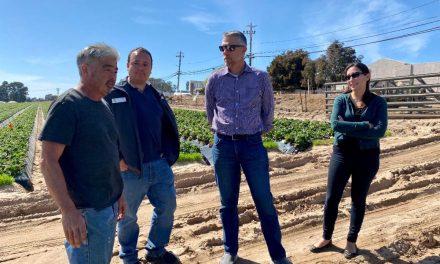Elements, natural and political, that are leading to the extinction of farmers and ranchers in California
CALIFORNIA — The small family farm was once the cover story of the American dream. But today, American farms are dying left and right, and American farmers are on their way to extinction — and arguably at a faster rate here in California.
According to the United States Department of Agriculture 2020 data, 1.4 percent of the nation’s population is responsible for farming. That equates to 2.6 million farming jobs providing for the 329.5 million people living in the United States.
To put that statistic into historical perspective, in 1840, nearly 70 percent of the American labor force worked in agriculture, and in 1935, the number of farms peaked at 7 million.
A United States Department of Agriculture (USDA) study found that in just five years (2007 to 2012), the nation experienced a net loss of 90,000 farms.
The loss of farmers and farms in America has not been an overnight decline, and it cannot be blamed on one entity or disaster.
Specifically speaking to California, one of the biggest differences between the Golden State and others is its strict regulations on agriculture, which San Luis Obispo County Farm Bureau Executive Director Brent Burchett says takes a major toll on small family farms that cannot afford to keep up with compliances.
“It hurts our family farms the worst,” he says.
Family farms cannot afford to keep up with increasing regulations involving how their crop is produced and in complying with labor laws — leaving large corporate farms as the only ones who can withstand the increased output.
“It is regulations that when you aren’t working in agriculture, on paper might look very rational,” says Burchett.
But he adds, “It’s harder now to make a living farming than it ever has been in our state’s history, and I think that message gets lost.”
On top of tight regulations, farmers face the impending drought still affecting the state.
“We didn’t get the rain we needed this year,” Burchett explains. “If we don’t get it this year, it will be pretty severe. It will be more [noticable] across the county. Right now, folks in North County are feeling it.”
He further explains the North County and inland areas are already feeling the dry effects of the drought. But, another year with inadequate rain will soon catch up to the county’s southern region, where the majority of vegetables are grown.
The effect of fewer crop production in the state will eventually trickle down to consumers and may be seen already in other states. But, as Burchett explains, a consumer coming into an SLO County Farmer’s Market and seeing the abundance of produce may not understand the fragile state agriculture currently finds itself in.
For the past few years, water use and farms has been the topic hardest for people to agree upon.
“It’s not an infinite resource. It has to be managed,” said Burchett. “We struggle with this balance between sustainability, making sure we are supporting habitat and environmental support, but I think the pendulum has swung too far that way, and we are losing our world-class agriculture here.”
California’s climate has made the state a primary agricultural state for the country, providing produce that other states have difficulties farming for one reason or another. So, in turn, when California farmers suffer, the rest of the country’s consumers all feel the effects — again, a trickle-down effect.
According to the California Department of Food and Agriculture’s (CDFA) California Agricultural Statistics Review for 2020-2021, agriculture sales have slowly been decreasing. Their report reads:
The sales value generated by California agriculture decreased by 3.3 percent between the 2019 and 2020 crop years. The state’s 69,600 farms and ranches received $49.1 billion for their output, down from the $50.8 billion received in 2019.
They also noted that in 2020, the number of farms operating in California had decreased 0.4 percent since 2019, equalling 69,600 farms currently operating in California and averaging about 349 acres each.
The report shows the number of crops decreased in production in the state exponentially, outway the increased crops.
Notable Decreases in California Production:
- Olives — 60 percent
- Safflower — 56 percent
- Barley — 53 percent
- Beans, Baby Lima Dry — 42 percent
- Beans, Garbanzo Dry — 38 percent
- Peppers, Chili — 38 percent
- Prunes — 36 percent
- Apricots— 29 percent
- Hay, Other — 29 percent
- Pears, All — 29 percent
- Spinach — 28 percent
- Cotton, American-Pima — 27 percent
- Cotton, All — 26 percent
- Cotton, Upland — 25 percent
- Potatoes, All (Excluding Sweet) — 25 percent
- Beans, Other Dry — 24 percent
- Asparagus — 23 percent
- Cottonseed — 23 percent
- Wheat, Durum — 22 percent
- Grapes, Raisin — 21 percent
- Hay, All — 20 percent
- Sunflower, All — 20 percent
UC Merced released a study in February this year outlining the economic impacts of the 2021 drought to California agriculture.
Their study found California farmers left nearly 400,000 acres of ag land unplanted last year because of the drought and withdrawn water rights. The result was a direct economic cost to farmers of $1.1 billion and the loss of nearly 9,000 agricultural jobs.
The American Farm Bureau reports, “One U.S. farm feeds 166 people annually in the U.S. and abroad. The global population is expected to increase by 2.2 billion by 2050, which means the world’s farmers will have to grow about 70 percent more food than what is now produced.”
This is a continuing story. Please see the future issues of Atascadero News as we dive deeper into agriculture’s increasing challenges.
SOURCES
vox.com/a/explain-food-america
washingtonpost.com/nation/2022/03/21/california-drought-vanishing-farms/
cdfa.ca.gov/Statistics/PDFs/2021_Ag_Stats_Review.pdf
wsj.com/articles/farmers-feel-the-squeeze-of-inflation-11644921180
















